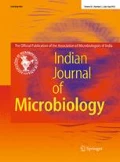Abstract
During an investigation of the disease profile of Withania somnifera, it was observed that leaf spot is the most prevalent disease. Repeated isolations from infected leaf tissues and pathogenicity tests showed the association of fungal pathogen identified as Alternaria alternata (Fr.) Keissler. Scanning electron microscopy showed various histological changes in the leaf tissues of infected plants. A decrease in total content of reducing sugars (20%) and chlorophyll (26.5%) was observed in diseased leaves whereas an increase was noticed in proline (25%), free amino acids (3%) and proteins (74.3%). High performance thin layer chromatography (HPTLC) analysis of secondary metabolites viz. withanolides, withaferin-A and total alkaloids of the diseased leaves vis-à-vis control revealed reduction in withaferin-A and withanolides contents by 15.4% and 76.3% respectively, in contrast to an increase in total alkaloids by 49.3%, information hitherto unreported in W. somnifera.
Similar content being viewed by others
References
Chopra RN, Chopra IC, Handa KL and Kapur LD (1958) Indigenous drugs of India. UN Dhar and Sons, Calcutta, India
Mabberley DJ (1997) The Plant-Book, 2nd edn. Cambridge University Press, Cambridge
Doaigey AR (1991) Occurrence, type, and location of calcium oxalate crystals in leaves and stems of 16 species of poisonous plants. Amer J Bot 78:1608–1616
Dhalla NS, Sastry MS and Malhotra CL (1961) Chemical studies of the leaves of Withania somnifera. J Pharm Sci 50: 876–877
Ghosal S, Kaur R and Srivastava RS (1988) Sitoindosides IX and X, glycowithanolides from Withania somnifera. Indian J Nat Prod 4:12–13
Kandil FE, El Sayed NH, Abou-Douh AM, Ishak MS and Mabry TJ (1994) Flavonol glycosides and phenolics from Withania somnifera. Phytochem 37:1215–1216
Uma Devi P (1996) Withania somnifera Dunal (Ashwagandha): Potential plant source of a promising drug for cancer chemotherapy and radiosensitization. Indian J Exp Biol 34:927–932
Singh S and Kumar S (1998) Withania somnifera: The Indian Ginseng Ashwagandha. Central Institute of Medicinal and Aromatic Plants, Lucknow
Gupta S, Kumar A and Thakur RN (1993) Some problems in cultivation of Withania somnifera (L.) Dunal (Ashwagandha) in Jammu region of India. J Res Edu Indian Med 33:234–235
Nagraj SD and Reddy DNR (1985) Pests infesting Withania somnifera (L.) Dunal and biology of Epilachna vigintioctopunctata. Indian Drugs 22:264
Bilgrami KS, Jamaluddin, Sinha RK and Prasad T (1979) Changes in seed content of paddy (Oryza sativa L.) due to fungal flora. Phytopathology 96:9–14
Singh P, Bhagat S and Ahmad SK (1990) Aflatoxin elaboration and nutritional deterioration in some pulse cultivars during infestation with A. flavus. J Food Sci Technol 27:60–62
Amusa NA, Ashaye OA and Oladapo MO (2003) Biodeterioration of the African star apple (Chrysophylum albidum) in storage and the effect on its food value. Afr J Biotechnol 2:56–59
Barnett HL and Hunter BB (1972) Illustrated genera of imperfect fungi. Burgess Publishing Company, Minneapolis, Minnesota, p 241
Awasthi RP and Kolte S1J (1994) Epidemiological factors in relation to development and prediction of Alternaria blight of rapeseed and mustard. Indian Phytopathol 47:395–399
Hsieh TF, Huang JW and Hsiang T (2001) Light and scanning electron microscopy studies on the infection of oriental lily leaves by Botrytis elliptica. European Journal of Plant Pathology 107:571–581
Sadasivam S and Manickam A (1991) Biochemical methods 2nd edn. New Age International (P) Limited, Publishers, New Delhi
Nelson NJ (1955) Colorimetric analysis of sugars. Methods Enzymol 3:85–86
Lowry OH, Rosebrough NJ, Farr AL and Randall RJ (1951) Protein measurement with the Folin phenol reagent. J Biol Chem 193:265–275
Trivedi RK, Goel PK and Trisal CL (1987) Practical methods in ecology and environmental sciences. Enviro Media Publications, Karad
Inoue K and Nasu H (2000) Black spot of peach caused by Alternaria alternata (Fr.) Keissler. J Gen Plant Pathol 66: 18–22
Lavern WT, Tobin LP, Zvi S and Kazuya A (2003) Alternaria diseases of citrus — novel pathosystems. Phytopathologia Mediterranea 42:99–112
Kohmoto K, Akimitsu K and Otani H (1991) Correlation of resistance and susceptibility of citrus to Alternaria alternata with sensitivity to host-specific toxins. Phytopathology 81:719–722
Mims CW, Rodriguez-Lother C and Richardson EA (2002) Ultrastructure of the host-pathogen interface in daylily leaves infected by the rust fungus Puccinia hemerocallidis. Protoplasma 219:221–226
Titarenko E, Hargreaves J, Keon J and Gurr SJ (1993) Defense-related gene expression in barley coleoptile cells following infection by Septoria nodorum. In: Fritig B and Legrand M (eds) Mechanisms of plant defense responses. Kluwer Academic Publishers, Dordrecht, pp 308–311
Graham TL, Kim JE and Graham MY (1990) Role of constitutive isoflavone conjugates in the accumulation of glyceollin in soybean infected with Phytophthora megasperma. Molecular Plant-Microbe Interactions 3:157–166
Hwang BK (1983) Contents of sugars, fruit acids, amino acids and phenolic compounds of apple fruits in relation to their susceptibility to Botryosphaeria ribis. J Phytopathol 108:1–11
Jeun YC and Hwang BK (1991) Carbohydrate, amino acid, phenolic and mineral nutrient contents of pepper plants in relation to age-related resistance to Phytophthora capsici. J Phytopathol 131:40–52
Alwadi HM and Baka ZA (2001) Microorganisms associated with Withania somnifera leaves. Microbiol Res 156: 303–309
Pitta-Alvarez SA, Spollansky T and Giulietti A (2000) The influence of different biotic and abiotic elicitors on the production and profile of tropane alkaloids in hairy root cultures of Brugmansia candida. Enzyme Microbiol Technol 26: 252–258
Author information
Authors and Affiliations
Corresponding author
Rights and permissions
About this article
Cite this article
Pati, P.K., Sharma, M., Salar, R.K. et al. Studies on leaf spot disease of Withania somnifera and its impact on secondary metabolites. Indian J Microbiol 48, 432–437 (2008). https://doi.org/10.1007/s12088-008-0053-y
Received:
Accepted:
Published:
Issue Date:
DOI: https://doi.org/10.1007/s12088-008-0053-y




